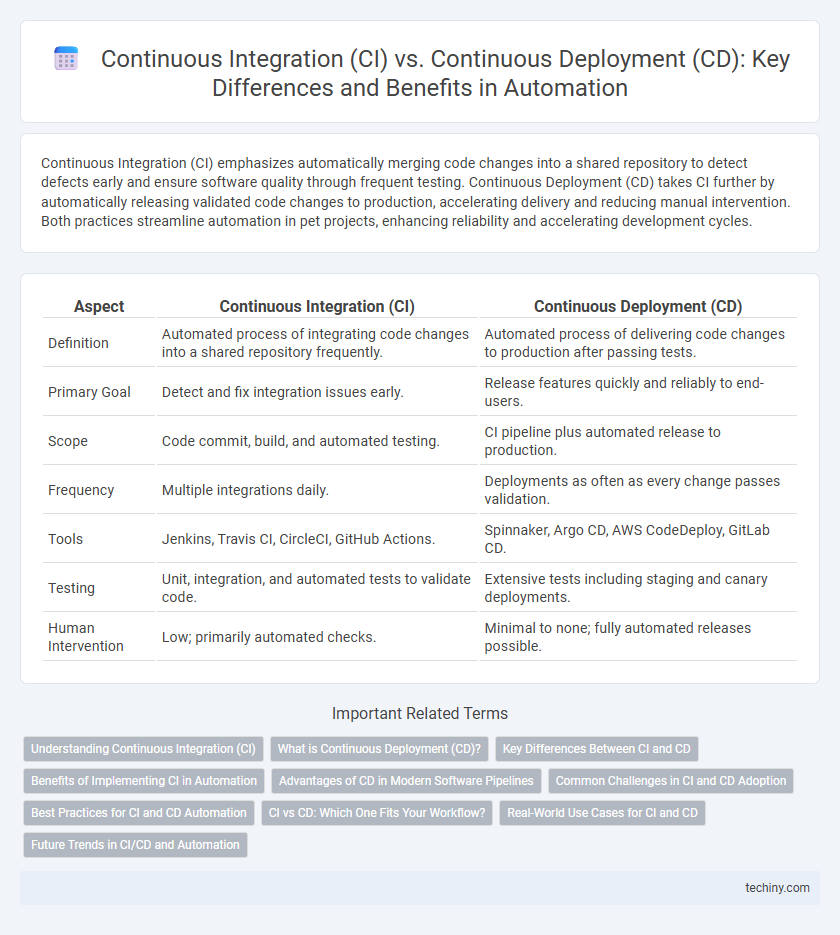Continuous Integration (CI) emphasizes automatically merging code changes into a shared repository to detect defects early and ensure software quality through frequent testing. Continuous Deployment (CD) takes CI further by automatically releasing validated code changes to production, accelerating delivery and reducing manual intervention. Both practices streamline automation in pet projects, enhancing reliability and accelerating development cycles.
Table of Comparison
| Aspect | Continuous Integration (CI) | Continuous Deployment (CD) |
|---|---|---|
| Definition | Automated process of integrating code changes into a shared repository frequently. | Automated process of delivering code changes to production after passing tests. |
| Primary Goal | Detect and fix integration issues early. | Release features quickly and reliably to end-users. |
| Scope | Code commit, build, and automated testing. | CI pipeline plus automated release to production. |
| Frequency | Multiple integrations daily. | Deployments as often as every change passes validation. |
| Tools | Jenkins, Travis CI, CircleCI, GitHub Actions. | Spinnaker, Argo CD, AWS CodeDeploy, GitLab CD. |
| Testing | Unit, integration, and automated tests to validate code. | Extensive tests including staging and canary deployments. |
| Human Intervention | Low; primarily automated checks. | Minimal to none; fully automated releases possible. |
Understanding Continuous Integration (CI)
Continuous Integration (CI) is a software development practice where developers frequently merge code changes into a central repository, triggering automated builds and tests to detect errors early. CI enhances code quality by enabling rapid feedback and reducing integration issues through continuous testing and validation. Tools like Jenkins, Travis CI, and GitLab CI facilitate streamlined workflows, ensuring consistent and reliable software development processes.
What is Continuous Deployment (CD)?
Continuous Deployment (CD) is an advanced automation process that automatically releases code changes to production environments after successful testing, eliminating manual intervention. It ensures rapid delivery of new features, bug fixes, and updates, enhancing software development lifecycle efficiency and reducing time-to-market. Continuous Deployment relies on robust Continuous Integration (CI) pipelines, automated testing frameworks, and infrastructure automation tools to maintain high-quality software releases.
Key Differences Between CI and CD
Continuous Integration (CI) focuses on automatically merging code changes into a shared repository, ensuring frequent code integration and early detection of issues through automated testing. Continuous Deployment (CD) extends this process by automatically releasing validated code changes into production, enabling faster and more reliable software delivery. The key difference lies in CI's emphasis on code integration and testing, while CD encompasses the entire release pipeline from code commit to production deployment.
Benefits of Implementing CI in Automation
Implementing Continuous Integration (CI) in automation accelerates software development by enabling frequent code integrations and early detection of defects, reducing integration issues and improving code quality. CI automates testing processes, ensuring that code changes are continuously verified, which decreases manual errors and accelerates feedback loops for developers. Enhanced collaboration and consistent codebase maintenance provided by CI lead to faster release cycles and more reliable software delivery.
Advantages of CD in Modern Software Pipelines
Continuous Deployment (CD) accelerates software delivery by automatically deploying code changes to production, reducing manual intervention and minimizing lead time. This approach enhances release frequency and improves feedback loops, enabling faster identification and resolution of issues. Automated deployment in CD fosters greater reliability and consistency, supporting agile practices and continuous improvement in modern software pipelines.
Common Challenges in CI and CD Adoption
Common challenges in Continuous Integration (CI) and Continuous Deployment (CD) adoption include managing complex toolchain integration, ensuring consistent testing environments, and addressing frequent build failures due to code conflicts or flaky tests. Overcoming cultural resistance and aligning cross-functional teams on automation best practices also presents significant obstacles. Furthermore, maintaining robust security and compliance standards while accelerating release cycles requires careful configuration and monitoring.
Best Practices for CI and CD Automation
Implementing Continuous Integration (CI) involves frequent code commits, automated testing, and integrating changes into a shared repository to ensure code quality and reduce integration issues. Continuous Deployment (CD) automates the release process by deploying every successful build to production environments, emphasizing robust automated testing, monitoring, and rollback mechanisms. Best practices for CI/CD automation include maintaining a comprehensive automated test suite, using version control for the entire pipeline configuration, and employing feature flags to enable safe releases and quick issue resolution.
CI vs CD: Which One Fits Your Workflow?
Continuous Integration (CI) emphasizes automated code integration and testing to detect defects early, ensuring code quality and stability. Continuous Deployment (CD) extends CI by automatically releasing validated code to production, accelerating delivery cycles and reducing manual intervention. Choosing between CI and CD depends on your team's readiness for automation, risk tolerance, and the need for rapid feedback versus immediate product updates.
Real-World Use Cases for CI and CD
Continuous Integration (CI) is widely used for automated testing and early bug detection in software development pipelines, enabling teams to merge code changes frequently and maintain stable builds. Continuous Deployment (CD) extends this automation by automatically releasing validated code to production, crucial in industries like e-commerce and finance where rapid delivery and minimal downtime are essential. Real-world examples include companies like Netflix leveraging CI for high-frequency code integration and Spotify using CD to deploy updates seamlessly across millions of users.
Future Trends in CI/CD and Automation
Future trends in Continuous Integration (CI) and Continuous Deployment (CD) emphasize increased adoption of AI-driven automation, enabling smarter code analysis and predictive failure detection. Integration of serverless architectures and edge computing accelerates deployment cycles while enhancing scalability and resilience. Enhanced security automation and compliance monitoring become standard, ensuring faster, safer delivery pipelines aligned with DevSecOps practices.
Continuous Integration (CI) vs Continuous Deployment (CD) Infographic

 techiny.com
techiny.com